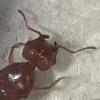AntsDakota,
Hm, not sure if I have Supermajors. When I think of Supermajors I think of Leafcutter Ants and how vastly different all their types of workers are. My megacephala have different sized Majors but the differences are so minimum I didn't even consider they could be a major and a supermajor. Do Pheidole Dentata have supermajors?
Very few ant species have supermajors. Some are in the genus Pheidole, but I doubt dentata do.
Correct. Ph. tepicana and Ph. rhea do in the US.
North America has 4 species of trimorphic Pheidole, those being P. tepicana, P. hirtula, P. obtusospinosa, and P. rhea. I believe the entire genus in total has 7 trimorphic species worldwide, although it's likely there are more than only 7 trimorphic species and we just haven't found their supermajors yet, as Pheidole supermajors tend to mostly stay within the nest.
All 7 species of Pheidole with true supermajors are present in the Southwestern Deserts of NA. They are as follows:
Pheidole rhea
Pheidole centeotl
Pheidole macclendoni
Pheidole hirtula
Pheidole obtusospinosa
Pheidole tepicana (this one may be as far East as Mississippi, although this is unlikely.)
Pheidole polymorpha
There is one other species, Pheidole calens, that most likely has supermajors present but it is yet to be confirmed. According to antmaps, this species is present in SA and parts of Central America but I suspect that these are mis-identifications as the vast majority of their records are from a handful of states in Central Mexico.
Trimorphic Pheidole spp. may exist outside of this one specific region of the New World. However, if they do exist, they are yet to be identified.
Of the phylogenic studies done on Pheidole spp. it appears that the first Pheidole sp. emerged in the New World whose descendants spread to Asia and Africa, then their descendants spread to Oceania. Because of this they have had much more time to diversify in the New World. Due to this head-start, it's not that unlikely that trimorphic Pheidole spp. are only found in the New World, possibly only that one specific region in which they've been identified in.



















